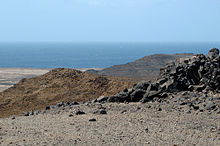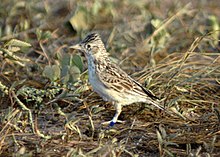Ilheu Raso
| Ilheu Raso | ||
|---|---|---|
| Satellite image | ||
| Waters | Atlantic Ocean | |
| Archipelago | Ilhas de Barlavento | |
| Geographical location | 16 ° 37 ′ 0 ″ N , 24 ° 35 ′ 57 ″ W | |
|
|
||
| length | 3 km | |
| width | 2.4 km | |
| surface | 7 km² | |
| Highest elevation | 164 m | |
| Residents | uninhabited | |
| Location within the archipelago | ||
The small, uninhabited island of Ilhéu Raso is part of the Cape Verde Islands .
etymology
The name of the island is derived from the Portuguese raso , which means level, flat - in terms of its leveled topography.
geography
The small island is one of the "islands above the wind", in Portuguese Ilhas de Barlavento , in the north of Cape Verde. It lies between Ilhéu Branco in the northwest and São Nicolau in the east. Ilhéu Branco is 8.5 kilometers away and São Nicolau is 15 kilometers away.
The uninhabited island is a maximum of 3 kilometers long and 2.4 kilometers wide. Its area is only seven square kilometers, but it is still larger than the neighboring Ilhéu Branco. The landscape of the Ilhéu Raso is mainly flat, smaller elevations with a maximum height of 164 meters can only be found in the north of the island. The southwest is characterized by a rocky plain strewn with boulders, which is criss-crossed by dry watercourses. The coastline is framed by cliffs.
geology
Like the rest of the islands of Cape Verde, the Ilhéu Raso is of volcanic origin. Your base sits 123 million years BP old oceanic crust from the Lower Cretaceous ( Aptian on). The former shield, consisting primarily of lava flows and pyroclastic deposits, has meanwhile been leveled very heavily.
Flora and fauna
There is little vegetation on the Ilhéu Raso, with the exception of a grassy landscape in the north.
The cliffs and rocky stretches of coast offer sheltered nesting sites, especially for sea birds. The Raso lark ( Alauda razae ) can be found on the island all year round , with a population of around 45 pairs. Other seabirds are found only to breed on the island, including the Cory's Shearwater ( Calonectris diomedea edwardsii ), the Little Shearwater ( Puffinus assimilis boydi ), the band-rumped storm-petrel ( Oceanodroma castro ) and the Bulwer's Petrel ( Bulweria bulwerii ). White-bellied booby ( Sula leucogaster ) and red-billed tropical bird ( Phaeton aethereus ) also form smaller colonies. The little egret ( Egretta garzetta ) and the birds of prey, osprey ( Pandion haliaetus ), Cape Verde barn owl ( Tyto detorta ) and kestrel ( Falco tinnunculus neglectus ) breed . The Cape Verde sparrow ( Passer iagoensis ) is also present.
In addition to the birds, reptiles populate the island. Up until the beginning of the 20th century, the Ilhéu Raso, together with the Ilhéu Branco, was the only place where the Cape Verdean giant drink Chiononia coctei was found . Since the beginning of the 20th century, however, no more specimens have been sighted and the lizard is considered extinct. The island is still home to some gecko species, including Tarentola gigas and Hemidactylus bouvieri .
Nature reserve
Because of its faunistic characteristics, the Ilhéu Raso was declared a nature reserve together with Santa Luzia and Ilhéu Branco ( Ilhas Desertas ) in 1990 .
climate
The Cape Verde islands are characterized by a very dry and evenly warm climate. This also applies to the Ilhéu Raso. The few precipitation falls in the months from August to October, the dry season from November to July. There are only minor temperature differences between summer and winter; the average temperature is over 20 degrees Celsius in all months.
See also
Individual evidence
- ↑ R. Muller, M. Sdrolias, W. Roest: Age, spreading rates and spreading symmetry of the world's ocean crust . In: Geochemistry Geophysics Geosystems . 9 (Q04006), 2008, p. 1525-2027 .
- ↑ Ilhéu Raso at Birdlife Data Zone (English)
- ↑ JC Hazefoet: The birds of the Cape Verde Islands . Ed .: British Ornithologists' Union. Tring, UK 1995 (BOU Checklist no.13).
- ^ A. Miralles, inter alia: An integrative taxonomic revision of the Cape Verdean skinks (Squamata, Scincidae) . In: Zoologica Scripta . 2010.






